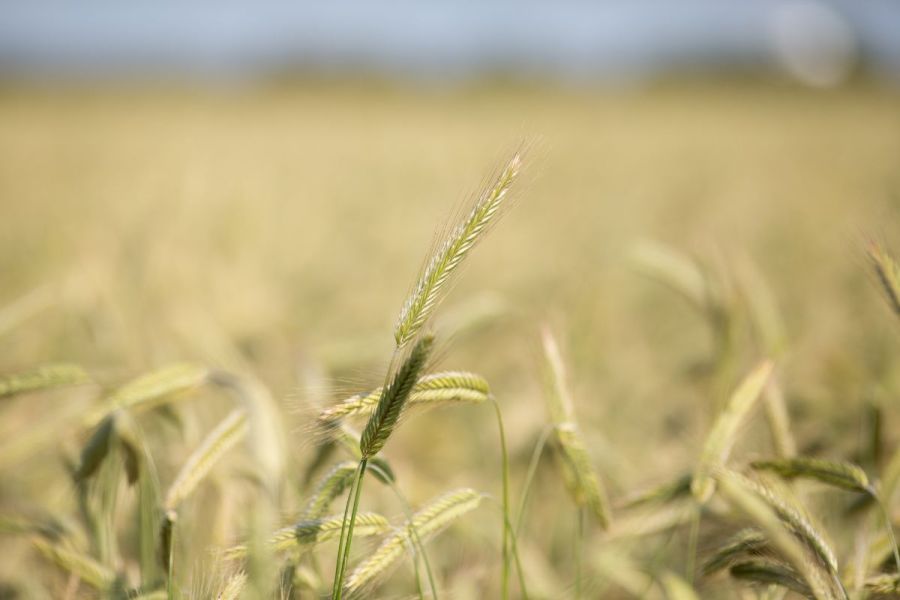Could hybrid rye be the new crop of the moment? CPM delves deeper into a series of trials which has flagged the benefits of hybrid rye both in terms of the crop’s growing requirements and its market potential.
“We’ve known for some time that fertiliser requirements with rye can be roughly half that of a second wheat.”
By Melanie Jenkins
The hybrid rye planted area has grown significantly in the past few years. With new research demonstrating the crop has a greater nitrogen use efficiency (NUE) than wheat or barley and that it can fit well in both pig and poultry diets without any negative effects, its appeal has really broadened.

The benefits of hybrid rye over conventional varieties has led to increasing interest in the crop, according to Dominic Spurrier.
Pre-2020, the area of hybrid rye grown in the UK totaled between 25,000ha and 35,000ha on an annual basis, but since then the area has jumped to around the 50,000-55,000ha mark, explains KWS’s Dominic Spurrier. “We’ve seen a big increase in the amount of hybrid rye grown but we probably saw a levelling off of the area last autumn.”
The benefits of hybrid rye over conventional varieties has led to increasing interest in the crop, he says. “Hybrid rye not only yields far beyond conventional rye, but new trials show it can deliver high yields at very low N inputs and there are many other increasingly important advantages too.”
Carried out by KWS and NIAB, nitrogen trials have demonstrated the hybrid rye variety KWS Tayo delivers a high NUE with applications as low as 80kgN/ha and near 11t/ha yields, says Olivia Potter of KWS.
“We’ve known for some time that fertiliser requirements with rye can be roughly half that of a second wheat, which when grown for feed is likely to require around 220kgN/ha. Hybrid rye typically requires 120kgN/ha, saving 100kgN/ha, but Tayo is showing the potential to cut this by a further third.”
One trial in North Walsham, Norfolk, saw the variety produce the same 10.84t/ha yield from both 80kgN/ha and 120kgN/ha fertiliser regimes, underlining the crop’s potential to help growers make major cost savings, she points out.
“Hybrid rye has a lot going for it in terms of marketing opportunities, benefits to the rotation and drought resistance, but its ability to produce high yields from relatively modest amounts of applied N is making it increasingly attractive,” says Olivia.

Hybrid rye’s ability to produce high yields from relatively modest amounts of applied nitrogen is making it increasingly attractive, says Olivia Potter.
According to Dominic, the crop’s benefits extend beyond just this cost saving. “It’s a fast-growing crop with a long drilling window that stretches from mid-September through to early November with a harvest earlier than wheat, so it ticks a lot of boxes regarding increasing demands for flexibility in the rotation.
“The crop’s speed of growth also gives it significant weed competition potential and disease is also less of an issue. It moves through stem elongation faster than any other cereal, with trials showing the competition it exerts against blackgrass helps reduce the viability of seeds by 60% compared with wheat.”
Often directed as a second cereal in the rotation, hybrid rye can provide a mini-break from diseases which may thrive in that situation. “Hybrid rye also has much higher resistance to take-all than triticale or winter wheat while the discovery of the Rfp1 ‘PollenPlus’ gene means ergot infection, a disease which rye is particularly susceptible to, is now significantly reduced,” he adds.
Known for its tall height, hybrid rye straw yields around 25-30% higher than wheat or barley. The crop is also a good choice for lighter land or drought-prone regions because of its water use efficiency, typically using 25% less than other cereal crops. This could be especially important because the soil moisture deficit (SMD) reached in late summer is forecast to become much more intense in future years, suggests Dominic.
“Last year was very dry in many parts of the country and February 2023 has been the driest on record, so water tables in most areas are still significantly behind where they should be in spite of the wetter than average March.”
In his view, that makes hybrid rye a crop to consider, particularly on free draining, acidic or sandy soils. “These are much more exposed to the risk of SMD to yields and rotational income, so rye has a valuable role to play in mitigating against this.”
One of the reasons hybrid rye is gaining popularity is that market opportunities have been opening up in recent years. As well as increasing demand from the food and distilling sectors, there are openings as an energy source for anaerobic digestion (AD) and greater use of rye in pig finishing rations.
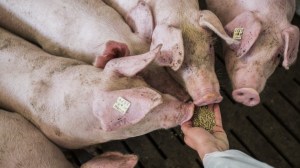
The UK pig sector is a potential market for rye because it’s a cheaper alternative to wheat and could offer a range of other benefits.
The pig sector is a major potential market for rye because, apart from being a cheaper alternative to wheat, it provides a range of additional key benefits, explains Dominic. “In Denmark, Germany, Russia, Poland, and Spain, for example, hybrid rye is already an established component in rations and now an increasing number of producers in the UK are recognising the advantages of providing pigs with rye-rich feed, including improved gut health and behaviour.”
According to interim results from a large-scale, long-term UK trial to evaluate its use as an alternative raw material in compound feeds, hybrid rye may be successfully included in finishing pig diets at rates of up to 60%.
A collaboration between ABN and KWS, the trial focused on the value of hybrid rye in feed for finishing pigs from 36kg to 115kg liveweight using hybrid rye grain.
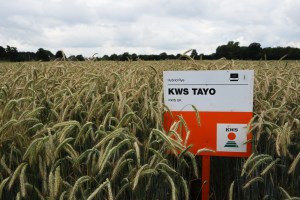
One advantage KWS Tayo offers is a reduced susceptibility to ergot as it contains the novel ‘PollenPlus’ trait bestowed by the Rfp1 gene.
“The positive results seen with hybrid rye are highly significant at a time when the sector is searching for sustainable raw materials,” says trial lead Dr Steve Jagger of ABN.
The trials consisted of four treatments, with rye included at 0%, 20%, 40% and 60%, replacing barley and wheat. Each treatment comprised three diets fed during three growth phases: 36-65kg, 65-85kg and from 85kg to finishing at 115kg liveweight. Approximately 4000 pigs were selected for the trial with 1000 in each treatment, with 50 pigs allotted to two mixed sex pens using a common feeder.
Two houses accommodating 1000 pigs each were used for the trial, which was then repeated. Each treatment was randomly allocated to individual pens in each house. The rye was cleaned to remove any contamination, analysed and nutrient values obtained before it was incorporated in the diets. These were formulated to contain the same level of net energy and ileal digestible lysine, the pellet quality index being ‘good’ for all treatments, explains Steve.
All diets included a xylanase enzyme and even when hybrid rye was included at the maximum 60% rate the product could still be pelleted without any production problems – a key factor in its commercial adoption, he explains.
“The results look very encouraging,” says Steve. “Neither growth rate, feed intake or feed conversion showed any significant differences between treatments.
“However, a significant effect was observed in the measurement of fat depths at the P2 position, which reduced at a rate of 0.2mm per 20% inclusion of rye. There was no notable effect of treatment on deaths and mortality, but these were lower on the rye diets.
“Rye’s energy and protein levels compare well with those of wheat and its non-starch polysaccharide or fibre content is associated with additional welfare and gut health benefits,” he explains.
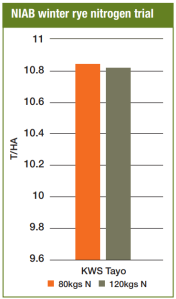
Source: NIAB, KWS, 2023
“Rye has a slow release of energy from the large intestine and increases satiety, which is why it has been associated with positive behavioural effects in finishing pigs and gestating sows. This effect may also be of value over the farrowing process, where a continued supply of energy may help reduce the number of stillborn piglets,” suggests Steve.
“Rye has also been associated with a reduction in ulceration, while its structure can improve gut health and lower skatole levels – responsible for ‘boar taint’ – reducing carcass odour. It also gives rise to high levels of butyric acid, which can lower the incidence of salmonella as well as increase the antibody levels in colostrum.”
Veterinarian Dr Richard Grone of KWS says the benefits of feeding rye have been proven by pig producers all over the world. “Major improvements in performance, health, behaviour, and welfare have been recorded in pigs from five weeks of age to fatteners, both in controlled conditions and commercial situations.”
Previous trials have assessed how the inclusion of rye in pig diets affects performance, he says. “These have shown promising results on growth rate, feed intake and feed conversion ratio. Although it hasn’t yet been included in compound feeds, there’s increasing interest in rye from producers because of its potential benefits.”
Hybrid rye can be substituted one-to-one for wheat and barley, so it offers many possibilities for feed compounders and producers, explains Richard. “The amount which can be included is not fixed and can be in a wide range from 20% to 70%, but most producers start using it at 30%-40%.
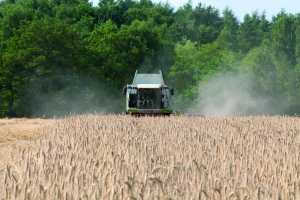
Known for its tall height, hybrid rye straw yields around 25-30% higher than wheat or barley.
“Rye can be fed as meal, liquid or pellet-based feed. It’s high in dietary fibre, which promotes satiety, gut health and calm behaviour. It can also boost energy supply at farrowing and its levels of arabinoxylan, which is converted to butyrate in the animal’s hind gut, far exceed those of wheat.
“However, rye is 2%-3% lower in crude protein than wheat but it does offer an excellent amino acid profile, particularity lysine. And its straw acts as a novel stimulus and helps to further reduce aggression.”
According to Chris Piggott of Frontier Agriculture, the initial results from the trial are in line with what had been expected. “The results are very encouraging because interest from arable farmers who are looking to grow hybrid rye is at a high level due to its significant agronomic and economic benefits in certain situations.
“To help develop the market for rye we have been working closely with potential end-users, including ABN. The project has been running for two years and considers all the commercial factors involved in using rye in compound feeds, from logistics and storage to ensuring that end products meet physical and nutritional requirements.”
“To establish rye as a viable option in the rotation, it’s essential to ensure that it works for the whole supply chain, from growers and the trade to the feed industry and other end-users,” he concludes.
Research briefing
To help growers get the best out of technology used in the field, manufacturers continue to invest in R&D at every level, from the lab to extensive field trials. CPM Research Briefings provide not only the findings of recent research, but also an insight into the technology, to ensure a full understanding of how to optimise its use.
CPM would like to thank KWS for sponsoring this Research Briefing and for providing privileged access to staff and material used to help bring it together.
This article was taken from the latest issue of CPM. Read the article in full here.
For more articles like this, subscribe here.
Sign up for Crop Production Magazine’s FREE e-newsletter here.

